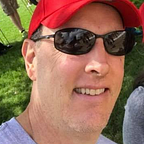Social Distancing and Restarting the Economy
I’ve been thinking about this a lot lately, both due to the need to get people back to work so we don’t fall into some new Great Depression, but also because of these right-wing group-backed protests to “open the country”, one of which took place not far from my Plano home, in downtown Frisco. Right-wingers marching around carrying long rifles and cosplaying as soldiers or militia or whatever has a way to focusing thought. And one thing I do need to be clear on: in some aspects I do agree with their sentiments: We cannot continue as we have. Folks need to work, we all need money to support our families, we need to put food on the table, we need to pay our bills and our mortgages. What we cannot have, however, is civil unrest, and dozens, or hundreds, of armed men showing up to protest is a powder keg ready to ignite.
This article, Our Pandemic Summer, by Ed Yong in The Atlantic, I think provides a good outline of what the next few months will bring. The key takeaways are:
- We need to accept that “life as most people knew it cannot fully return,” at least not soon, or possibly ever.
- We need to think in terms not of a few weeks or even a few months, but rather in terms of 18–24 months, or more, before we can really get back to what we’d consider our “normal” lives.
- We can’t think in terms of “ending” the shut down, or “ending” social distancing. “Everyone wants to know when this will end,” said Devi Sridhar, a public-health expert at the University of Edinburgh. “That’s not the right question. The right question is: How do we continue?”
Read this article, especially if you want to post below. What we need now, more than ever, is honest and forthright discussion based on acceptance and understanding of scientifically proven facts, not rumors or conjecture or whatever nonsense Trump is saying — nor the happy horseshit being spread by our local leaders, whether that is Governor Abbott, Judge Chris Hill, or any of a number of other right-wingers who are not interested in saving lives but rather making political hay by risking our lives.
- There are things that we can personally do, and should be thinking about.
- Accept that the novel coronavirus and COVID-19 are real, can be deadly, and are far more serious and transmissible than other illnesses that we are more familiar with, like influenza or a cold. This is becoming a partisan thing, with conservatives disbelieving these facts. It should not be, and we must insist that folks believe them.
- Wear a face mask. Masks aren’t necessarily going to protect the wearer from being exposed to the coronavirus; they greatly reduce the wearer’s ability to transmit the virus if he or she is infectious. If we all wore masks in public, we significantly reduce the spread even if more people are out and about. And don’t try to obtain N-95 masks; our medical pros need those. A cloth mask, which you can make or buy, is sufficient for our needs.
- Start thinking of the long term. We need to think in terms of “before coronavirus” and “after coronavirus.” We are now in the after. We’re not going back to “before” any time soon, if ever. We will need to adjust to new normals if we’re going to get back to work, get our kids back to school, and start living our “new normal” lives.
- Be supportive of our neighbors and others who we are in this together with. You don’t know the circumstances that someone is in. You don’t know if they, or a family member, is immune compromised, or otherwise at risk. Give people space. Don’t hoard items. Be nice. We’re all struggling.
More than anything, what we need is what we’re not going to get, which is Federal and State leadership that is factual, results-oriented, and ready to do things that are constructive. The stock market crash that triggered the Great Depression happened, as we all know, in October 1929, just 7 months into Herbert Hoover’s administration. Yet for the next 3 years, he did next to nothing, believing that the market and the wealthy would would work out the economic problems. They never did, and the Depression only grew worse, until Franklin Roosevelt was elected, took office, and immediately set about greatly expanding the Federal government via what he called the “New Deal.” It could very well be that we’ll need to wait until a President Biden Administration in January 2021 before we get a truly aggressive, expansive, and importantly effective Federal response to the pandemic. I only hope that we can make it that long without major or significant social disruption, or worse, civil unrest or rioting.
From the article, “As the rest of the U.S. comes to terms with the same restless impermanence, it must abandon the question When do we go back to normal? That outlook ignores the immense disparities in what different Americans experience as normal. It wastes the rare opportunity to reimagine what a fairer and less vulnerable society might look like. It glosses over the ongoing nature of the coronavirus threat. There is no going back. The only way out is through — past a turbulent spring, across an unusual summer, and into an unsettled year beyond.”
Note: Ed Yong was the guest on KERA’s Think podcast on April 23, 2020, and discussed his article “Our Pandemic Summer” as well as other aspects of the pandemic and the government response. It’s worth a listen.
